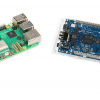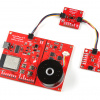×
SparkFun will be closed on Tuesday, December 24th, and Wednesday, December 25th, in observance of the Christmas holiday. Any orders qualifying for same day shipping placed after 2:00 p.m. (MST) on Monday, December 23rd, will be processed on Thursday, December 26th, when we return to regular business hours. Wishing you a safe and happy holiday from all of us at SparkFun!
Please note - we will not be available for Local Pick up orders from December 24th-December 27th. If you place an order for Local Pick-Up we will have those ready on Monday, December 30th.
This is a guest blog post by Mark Phillips, VP of Buisness Development at Helium. Helium was founded in 2013 by Shawn Fanning, Amir Haleem and Sean Carey, with a mission to make it easier to build connected devices.
Helium recently announced that the Helium Network is now the largest, public LoRaWAN network in the United States. On the heels of this, we wanted to properly (re)introduce the SparkFun Developer Community to the Helium Network, and put together a few tutorials to ensure you could quickly take advantage of Helium for IoT applications.
This post will be the first of several published with our friends and partners here at SparkFun. To follow this up, we’ll walk you through building an end-to-end application using Helium, AWS IoT, and the SparkFun Pro RF. But today we’re focusing on the high level pieces. So let’s dive in.
Jumpstarting a nationwide IoT network
Helium was founded in 2013 with a mission that looks very similar to what we are doing now: providing developers and enterprises with a ubiquitous, public wireless network for IoT devices and data. Based on six years of experience, and thousands of pilots and customer engagements, we’ve arrived at an end-to-end network design that we believe solves the connectivity problem holding back the IoT space.
Beginning in August 2019, we deployed the first Hotspots in Austin, Texas (and, in parallel, brought the Helium blockchain online). In the seven short months since, the Helium Community has built the largest public LoRaWAN in the United States, with over 3,200 Hotspots online in all 50 states, capable of routing bi-directional sensor data for any device running LoRaWAN v.1.0.2.
The Hotspot, the Helium blockchain, and a network deployed by people
To accomplish this explosive growth, we relied on three things:
- The Helium Hotspot - Our consumer version of a LoRaWAN gateway. It routes data and acts as a full blockchain miner.
- The Helium blockchain - Yes. There is a blockchain. And, no, we didn’t bolt it on to hit more buzzwords. We needed a solution to level the traditional, CapEx-heavy wireless network rollout economics. And in the process we landed on a design that verifies the integrity of the Helium Network to make it more useful for you, the developers.
- People (like you) - Most of the thousands of Hotspots are deployed by people and businesses who don’t have devices on the Network. They do so because they want to be part of a decentralized wireless movement, and be rewarded in HNT, the native token of the Helium blockchain. In fact, just south of the SparkFun offices in Boulder, Colorado, a local group is rolling out 50 Hotspots as we speak.
On this foundation, we were able to offer a better LoRaWAN network, faster. And while Helium coverage continues to be built - soon with any LoRaWAN gateway (more on this coming) - we’re now switching our focus to onboarding developers and their devices.
A developer-focused Network with enterprise-grade capabilities
“The ability to focus on innovation quickly in our devices knowing that the transit of messages is secure lets us continue to work on this effort without a large team. Helium provides the right mix of low power, high security, and robust coverage in urban locations that we'll need to grow this program further.” Jay Langust, Senior Application Architect at Salesforce
If you’re reading this, you’re likely one of the hundreds of thousands of developers, architects, CxOs and line-of-business executives that sees IoT and, increasingly, LoRaWAN as the solution to a sensor-based problem you have. The Helium Network, and the tooling and features we’re building, is designed to meet the needs of all of you.
Our goal is to bridge the gap, and deliver a platform that both satisfies things that enterprises need while also maintaining a deep commitment to building best-in-class developer tools. Some of what we’re working on (and have already released) includes:
- The Helium Console, our web-based device management interface `
- A fully-featured CLI for provisioning the deployment of devices and applications
- Support for any LoRaWAN v1.0.2 device (with 1.0.3 and 1.1 on the horizon)
- Features like labels that make building application-level logic flexible and logical
- Complete, simple integrations with HTTP and MQTT endpoints, major cloud providers, and (soon) much more.
- Full API support for all parts of the Network
- Device diagnostic tooling that optimizes LoRaWAN configurations and firmware before they are deployed
Plus, nearly everything we do is open source under friendly licensing. We’re committed to being open and transparent, and if you want to contribute code or deploy some or all of the Helium Network on your own, we’re all for it.
Join the Helium Network, now
In the next post, we’ll do a full walk through of onboarding a SparkFun Pro RF-based sensor to the Helium Network. Until then, here’s what you can do to get involved now:
- Buy a Helium Hotspot (or build your own developer version)
- Sign up for Helium Console and deploy your first device
- Dig into the complete developer documentation
- Join our community of thousands in the Helium Developer Slack
- Explore the full Helium blockchain









